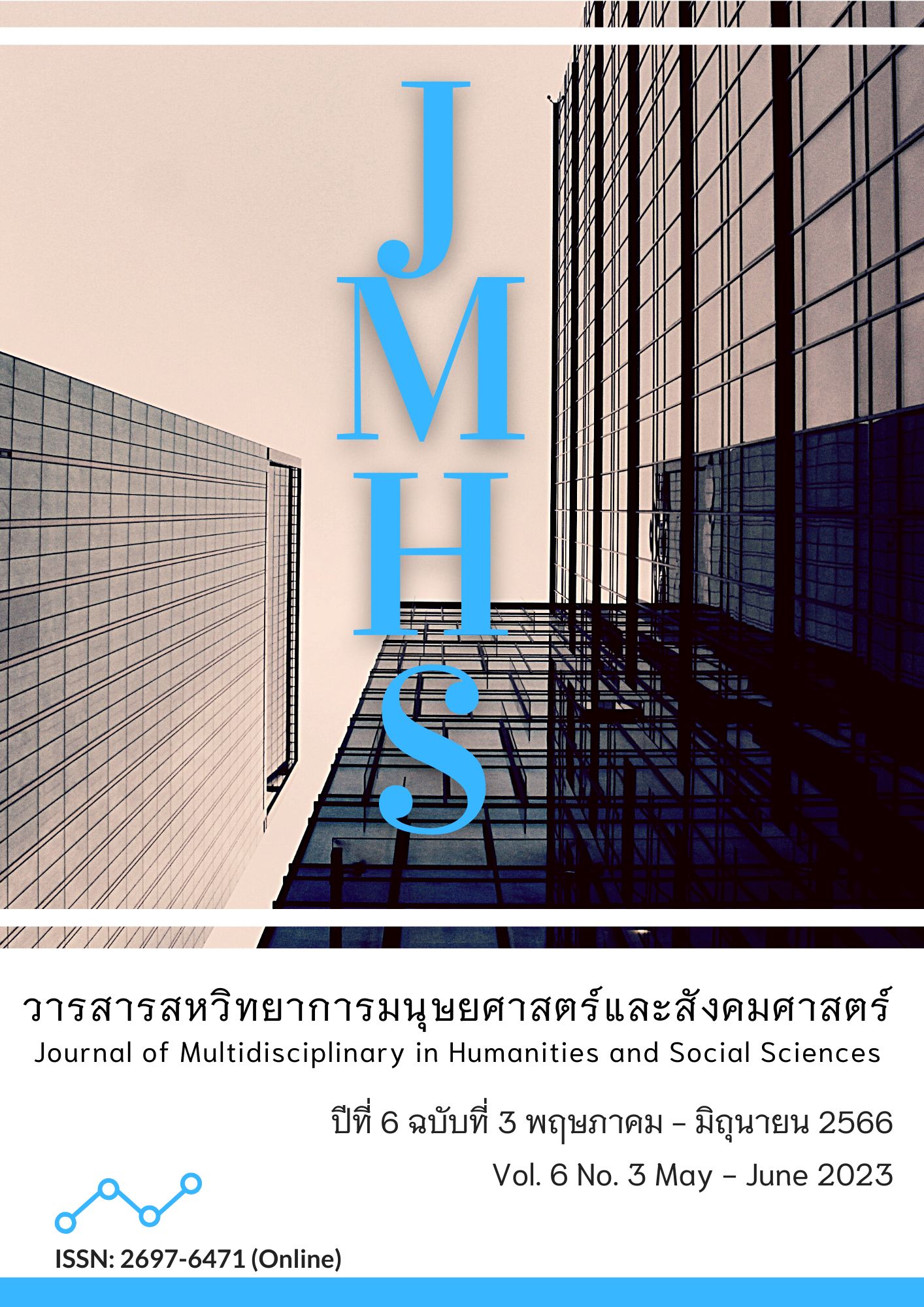Causal Factors Influencing Decisions to Study Undergraduate Studies of Students at Rangsit University
Main Article Content
Abstract
The purposes of this article were to: 1) develop and validate a causal relationship model of influencing decisions to study undergraduate studies of Rangsit University students; and 2) study the causal factors influencing decisions to study undergraduate studies of Rangsit University students. This study was quantitative research. The tools used in the research were online questionnaires. The sample consisted of 410 people studying for a bachelor's degree at Rangsit University by simple sampling. The statistics used in data analysis were frequency, percentage, confirmatory factor analysis, and the structural equation model.
The research results were found as follows: 1) The causal relationship models comprise four components: social media usage, electronic word of mouth, trust, and decisions to study. The model is consistent with the empirical data to a great extent. The statistics show CMIN/df = 2.01, GFI = 0.93, AGFI = 0.91, SRMR = 0.05, and RMSEA = 0.05. The final prediction coefficient was 0.59, indicating that the variables in the model can explain the variance of the decisions to study undergraduate studies of Rangsit University students by 59 percent. 2) Both trust and electronic word of mouth had respective influences on the decisions to study. However, Rangsit University should consider the trust of students. The findings of this study will help Rangsit University plan and recruit new students more efficiently in the future.
Article Details

This work is licensed under a Creative Commons Attribution-NonCommercial-NoDerivatives 4.0 International License.
Views and opinions appearing in the Journal it is the responsibility of the author of the article, and does not constitute the view and responsibility of the editorial team.
References
กชกร บุญยพิทักษ์สกุล และ พิชญาณี พูนพล. (2562). ปัจจัยที่เกี่ยวข้องกับพฤติกรรมการใช้สื่อสังคมออนไลน์อย่างรู้เท่าทันของนักศึกษาปริญญาตรีในเขตกรุงเทพมหานครและปริมณฑล. วารสารพฤติกรรมศาสตร์, 25(2), 139-159. สืบค้นจาก https://so06.tci-thaijo.org/index.php/BSRI /article/view/184439/
เดลินิวส์ ออนไลน์. (2565, 26 ธันวาคม). มหาวิทยาลัย’ แข่งขันดุเดือด! แก้วิกฤติใหญ่ขาดแคลนนักศึกษา. สืบค้นเมื่อ 7 เมษายน 2566, จากhttps://www.dailynews.co.th/articles/1824800/
ณฐวัฒน์ คณารักสมบัติ. (2560). การรับรู้สื่อประชาสัมพันธ์ของนักศึกษาที่มีผลต่อการตัดสินใจเข้าศึกษาต่อในมหาวิทยาลัยราชภัฏธนบุรี สมุทรปราการ. วารสารมหาวิทยาลัยราชภัฎลำปาง, 6(1), 55-66. สืบค้นจาก https://so04.tci-thaijo.org/index.php/JLPRU/article/view/91023
ตฤณสิษฐ์ วรพันธ์พิมล, อิราวัฒน์ ชมระกา และ ชัชชัย สุจริต. (2565). คุณภาพบริการและความไว้วางใจของลูกค้าที่มีต่อการตัดสินใจเข้าใช้บริการสนามฟุตบอลหญ้าเทียมอุตรดิตถ์ยูไนเต็ด. วารสารวิทยาการจัดการมหาวิทยาลัยราชภัฏพิบูลสงคราม, 4(3), 63-78. สืบค้นจาก https://so03.tci-thaijo.org/index.php/jmspsru/article/view/262749/
นันธิการ์ จิตรีงาม. (2561). การสื่อสารการตลาดแบบบูรณาการที่มีผลต่อการตัดสินใจเลือกศึกษาต่อในสถาบันอุดมศึกษาของนักเรียนมัธยมศึกษาปีที่ 6 จังหวัดนนทบุรี. วารสารนิเทศสยามปริทัศน์, 17(23), 47-58. สืบค้นจาก https://so02.tci-thaijo.org/index.php/ISSC/article /view/249341
พัชณี เพชรอาวุธ, สิรินธร สินจินดาวงศ์, และ วีระ สุภากิจ. (2561). ยุทธศาสตร์การพัฒนาภาพลักษณ์สถานศึกษาสังกัดสำนักงานคณะกรรมการการอาชีวศึกษา. วารสารมหาวิทยาลัยนราธิวาสราชนครินทร์ สาขามนุษยศาสตร์และสังคมศาสตร์, 5(1), 24-35. สืบค้นจาก https://so05.tci-thaijo.org/index.php/pnuhuso/article/view/110095
มหาวิทยาลัยรังสิต. (2553). Welcome to Rangsit University. สืบค้นเมื่อ 25 ตุลาคม 2565, จาก https://www2.rsu.ac.th/info/welcome-to-rsu
ยุภาพร นอกเมือง, Luo Xun และ สันติพงษ์ ทองดี. (2563). การศึกษาปัจจัยที่ส่งผลต่อแรงจูงใจในการตัดสินใจศึกษาต่อทางด้านภาษาจีนระหว่างมหาวิทยาลัยในประเทศไทยกับมหาวิทยาลัยในประเทศจีนของนักเรียนชั้นมัธยมศึกษาปีที่ 6 แผนการเรียนภาษาอังกฤษ-ภาษาจีนโรงเรียนในพื้นที่จังหวัดปทุมธานี. วารสารการบริหารนิติบุคคลและนวัตกรรมท้องถิ่น, 6(6), 107-119. สืบค้นจาก https://so04.tci-thaijo.org/index.php/jsa-journal/article/view/243087
รัตนา อัตภูมิสุวรรณ์ และ สุภมาส อังศุโชติ. (2560). กระบวนการตัดสินใจซื้อและการกำนดปัจจัยการบริโภคที่มีอิทธิพลต่อพฤติกรรมการบริโภคแบบยั่งยืนของบุคลากรในสถาบันอุดมศึกษา. วารสารวิจัยและพัฒนา มจธ, 40(1), 3-16. สืบค้นจาก https://digital.lib.kmutt.ac.th/journal /loadfile.php?A_ID=829
วรรนิสา หนูช่วย และ ประกอบ กรณีกิจ. (2562). การพัฒนารูปแบบการเรียนโดยใช้โครงงานเป็นฐานด้วยสื่อสังคมออนไลน์เพื่อส่งเสริมการรู้สิ่งแวดล้อมของนักเรียนชั้นมัธยมศึกษาตอนปลาย. วารสารอิเล็กทรอนิกส์ เวอร์ริเดียน มหาวิทยาลัยศิลปากร (มนุษยศาสตร์ สังคมศาสตร์ และศิลปะ), 12(1), 1456-1470. สืบค้นจาก https://he02.tci-thaijo.org/index.php/Veridian-E-Journal/article/view/150963
เว็บไซต์ HREX.asia. (2562, 25 มิถุนายน). การศึกษา (Education) สำคัญอย่างไรกับการพัฒนาทรัพยากรมนุษย์. สืบค้นเมื่อ 7 เมษายน 2566, จาก https://th.hrnote.asia/orgdevelopment/190625-education-for-hrd/
ศิวฤทธิ์ พงศกรรังศิลป์. (2555). หลักการตลาด. กรุงเทพฯ: ท๊อป.
อลงกรณ์ อัมมวงศ์จิตต์, ศรีรัฐ ภักดีรณชิต และ นพดล อินทร์จันทร์. (2565). ปัจจัยที่ส่งผลต่อการตัดสินใจเลือกเข้าศึกษาต่อระดับปริญญาตรีที่วิทยาลัยนวัตกรรมสื่อสารสังคม มหาวิทยาลัยศรีนครินทรวิโรฒ. วารสารนวัตกรรมและการจัดการ, 7(1), 53-68. สืบค้นจาก https://so03.tci-thaijo.org/index.php/journalcim/article/view/258107
ไอรินทร์ พงศ์อมรรัชต์. (2564). อิทธิพลต่อการตัดสินใจในการส่งต่อข้อมูลผลิตภัณฑ์เครื่องดื่มเฟรนไชส์ของผู้บริโภคใน ประเทศไทย. วารสารวิชาการ สถาบันเทคโนโลยีแห่งสุวรรณภูมิ, 7(2), 535-549. สืบค้นจาก https://so04.tci-thaijo.org/index.php/svittj/article/view/230389
Hair, J. F., Black, W. C., Babin, B. J., & Anderson, R. E. (2010). Multivariate Data Analysis. (7th ed.). Upper Saddle River, NJ: Prentice Hall.
Hair, J. F., Hult, G. T. M., Ringle, C. M., & Sarstedt, M. (2014). A Primer on Partial Least Squares Structural Equation Modeling (PLS-SEM). California, CA: Sage Publications.
Hoelter, J.W. (1983). The Effects of Role Evaluation and Commitment on Identity Salience. Social Psychology Quarterly, 46(2), 140–147. Retrieved from https://doi.org/10.2307/3033850
Joreskog, K.G., & Sorbom, D. (1984). Advances in Factor Analysis and Structural Equation Models. Lanham: Rowman & Littlefield Publishers.
Kline, R.B. (2011). Principles and Practices of Structural Equation Modeling (3rd ed.). New York The Guilford Press.
Lassoued, R., & Hobbs, J.E. (2015). Consumer Confidence in Credence Attributes: The Role of Brand Trust. Food Policy, 52(1),99-107.
Schreiber, J. B., Stage, F. K., King, J., Nora, A., & Barlow, E. A. (2006). Reporting Structural Equation Modeling and Confirmatory Factor Analysis Results: A review. The Journal of Educational Research, 99(6), 323–337. Retrieved from
https://doi.org/10.3200/JOER.99.6.323-338
Schumacker, R. E., & Lomax, R. G. (2004). A Beginner's Guide to Structural Equation Modeling. (2nd ed.). Lawrence Erlbaum Associates Publishers.
Thompson, B. (2004). Exploratory and Confirmatory Factor Analysis: Understanding Concepts and Applications. American Psychological Association.
Vongurai, R., Elango, D., Phothikitti, K., & Dhanasomboon, U. (2018). Social Media Usage, Electronic Word of Mouth and Trust Influence Purchase-Decision Involvement in Using Traveling Services. Asia Pacific Journal of Multidisciplinary Research, 6(4), 32-37.
Retrieved from http://www.apjmr.com/wp-content/uploads/2018/08/APJMR-2018-6.4.04.pdf
Ullman, M. T. (2001). The Declarative/procedural Model of Lexicon and Grammar. Journal of Psycholinguistic Research, 30(1), 37–69. Retrieved from https://doi.org/10.1023/A:1005204207369


